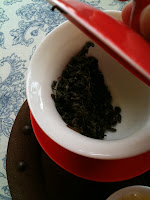Semi-oxidized tea in Chinese are called collectively Qingcha literally meaning ‘clear tea.’
This is also known as Oolong meaning black dragon.
The processing of this tea is achieved by a combination of techniques used for green and black tea.
The way it is oxidized the resulting tea is most refined.
The oxidation will usually range from 10% to 70%.
The leaves are either oven roasted – bake cultivation, dry roasting or lightly over a low charcoal fire.
Roasting tea leaves is mean to remove unwanted and foreign odors, reduce astringency or sour tastes as well as making it more digestible and less harsh on the stomach enzymes.
The varieties of this tea is based on the kinds of trees that the leaves are harvested from and each varietals will call for its own unique particular way of processing methods and quality.
The leaves are processed in two different ways – rolled into long curly leaves like the Dan Cong, Baozhong or Da Hong Pao; or pressed and rolled into tea pearls like the Dong Ding, Gunpowder, and Tit Kuan Yin.
The latter method of processing is more recent and the former an older method.
This is usually done before roasting.
Rolling and bruising the leaves helps to stimulate enzymatic activity and to break open the cell walls.
The flavors of oolong teas are closer to green teas rather than black teas.
Aromas of oolong teas are usually classified as floral , fruity, melony or honey-like; the flavors or tastes and aftertaste as sweet, bitter, mellow, rich, refined or moistening.
Most oolong teas are consumed after production however some benefit through the aging process with regular revivals through light roasting.
Oolongs are usually brewed strong, with a higher bitter aftertaste, although, all brewing strengths are dependant on the individual taste.
Honey Orchid Phoenix Dan Cong
Fujian Oolong
Taiwan BaoZhong















































